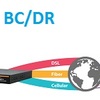I had an interesting conversation with Ken LaMere, Director of Channel Sales at Ecessa, that resulted in am email interview about SDN, software defined network, with Ken and Mike Siegler, VP Development & Technical Support. I was letting this acronym build momentum before I wrote about it. This is a good primer on SDN for channel partners.
Question 1: The Channel saw tw telecom delivering Dynamic Bandwidth prior to the Level3 acquisition. Is that the first case of SDN-WAN? If not, how is it different?
Mike Siegler, VP Development & Technical Support, answers, "Yes, you could say this is an early demonstration of how a Software Defined Network, or Software controlled network, can add value to a business. We see any technology that intelligently monitors, adapts, controls, improves, or manages a WAN link as SDN, SD-WAN, or other acronym we want to select. If we can control the performance of your WAN via Software, you are benefiting from this technology. Today, the options are far greater and the technology more powerful than basic Dynamic Bandwidth options provided in the past."
Question 2: For telecom agents, what one thing should they keep in mind to identify an SDN-WAN opportunity?
Ken LaMere replied, "I think of 3 potential benefits SD- WAN as being broken into three primary elements. Below I will list some common scenarios that lead to companies to consider SD-WAN:"
Network Performance is one.
- Companies that have applications that do not perform well over their current WAN (VOIP, VDI, Video being the most common)
- Companies that are experiencing congestion over current WAN
- Companies that are unable to deploy the applications they want due to WAN limitations
- Limited carrier service options that meet the customers need or budget in their area
Network Resiliency is two.
- Companies that have realized the cost and pain of a recent WAN outage (1# of all)
- Companies that have a current failover option that still disrupts business (long failover and or failback times)
- Failover solutions that limit the WAN performance, I.E. only some applications failover and or perform poorly in failover mode
- Companies that have not implemented a failover solution due to complexities or costs associated
Network Visibility and Alerting is the third element.
- Want to be notified of any WAN outage. Not only loss of service but when transport effecting conditions are present such as high latency
- Would like a way to validate all carrier services such as Bandwidth utilization to ensure they are getting what they are paying for
- Would like to review their data usage trends historically to predict future needs
- Need an effective tool to quickly trouble shoot poor application performance or other network issues
Question 3: Why are people saying that MPLS is going away?
Ken LaMere writes, "The most provocative way to get someone's attention in technology is to say that something is obsolete. MPLS still plays a part in many SD-WAN deployments because it still adds value to the WAN. What is changing is the limitations in the past that we faced in building a WAN. SD-WAN is about blending additional transport options to achieve incredible results that cannot be achieved by MPLS by itself. Do we have SD-WAN deployments that have replaced MPLS? Yes We also have deployed SD- WAN into networks with Primary and Secondary MPLS networks. < br/> The transport that SD-WAN runs on depends on several factors such as: network goals/needs, budget, and availability of services. We feel that SD-WAN does not replace MPLS but it just flat out makes it better just like we make broadband based WANS better than by itself. It is also very common to blend MPLS and broadband as they are very complimentary to each other."
Question 4: How does SDN-WAN replace a private network system like MPLS?
Mike Siegler, VP Development & Technical Support , writes, "The straight forward answer is that SD-WAN provides a greater level of WAN performance and resiliency using any transport type that might be available whether it is copper, fiber, coax or wireless." "SD-WAN will change the way WAN's are thought of and deployed. Telecom consultants and engineers will now have options to solve WAN challenges that were previously unavailable or unacceptable. Carriers will continue to adopt SD-WAN capabilities and provide them as a product as they do MPLS today. Until it is adopted and mastered by the masses it represents a big opportunity for agents, carriers and SD-WAN companies that are willing to understand it and thoughtfully engineer and deploy it."
Fast on the heels of cloud services comes even more technology for channel partners to learn about. SDN-WAN is new, but set to explode in some areas (like NFL cities), because companies are migrating to cloud services without taking into account how much bandwidth that will consume, especially for real time apps like voice, video and virtual desktop.
There will be WAN (and LAN) congestion due to excessive traffic. SDN-WAN may help in some situations. With a channel show or four (CPExpo, Tampa Channel Direction, CVX Expo, ITEXPO, Microcorp One-on-One) in the next 6 weeks, take the opportunity to invest in some education about the new technology. Find a vendor who can explain it as easily as Ecessa did here. If they can't explain it so you understand, then they don't know what they are doing yet.












